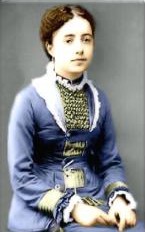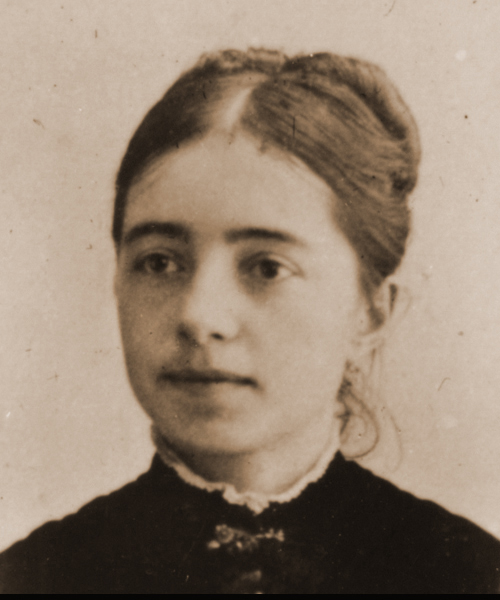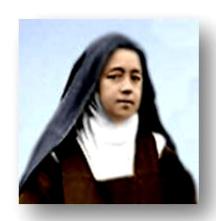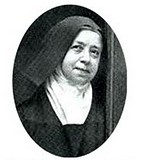MARIE - “Prayer is the state of my soul.”






Marie Louise Martin was born in Alençon, France, on February 22, 1860, the first-born of the nine children of Louis and Zélie Martin. She had a strong and fearless spirit, and was straightforward and frank. Her family’s nickname for her was “Gypsy;” however, later in life, her father would also nickname her his beloved “Diamond”.
In October 1868, Marie entered the Visitation boarding school in Le Mans, France. Her aunt (her mother’s sister), Sister Marie-Dosithée, a nun who taught there, gave the Martin Sisters both spiritual and moral guidance while they were students. However, because Sr. Marie-Dosithée had been diagnosed with Tuberculosis, Marie’s First Holy Communion was moved up one year to ensure her aunt could be there. Meanwhile, Marie prayed to St. Joseph to intercede for her aunt’s cure. Not only was her aunt there to witness Marie’s First Holy communion on July 2, 1869, but she also lived for seven more years!
When Marie received the news that her baby sister Mélanie died on October 8, 1870, she couldn’t stop crying; but she immediately wrote to her mother to try and comfort her. Then on July 19, 1870, the Franco-Prussian War began. Once the Germans had advanced onto Le Mans, the parents of the students all went to the school to bring their children home. Sadly, Le Mans fell on January 11, 1871, and the Germans used the boarding school as an army hospital. Next to fall was the town of Alençon. As the German army advanced and the bombs landed nearby, Zélie led all of the children into the root cellar. Once the smoke cleared and the town officially surrendered, the Germans forced each French family to house a number of soldiers. The Martin family housed nine of them on the bottom floor of their house. After the occupation ended on May 10, 1871, both Pauline and Marie returned to the Visitation boarding school in Le Mans.
On January 4, 1873, when her youngest sister Thérèse was baptized, Marie became her godmother. Later that same year, Marie contracted typhoid fever and was sent home from school. Her father made an eighteen-mile pilgrimage on foot to a church to pray for her cure, and she eventually recovered. After completing her studies on August 2, 1875, she began assisting Pauline in home schooling her little sisters. Later, she became very upset when Zélie brought up the subject of marriage. She told her mother that she would never marry and begged her to not bring up the subject again.
By the Summer of 1877, Zélie knew she was dying of breast cancer. Marie promised to continue the rearing of the youngest girls. Marie stayed by her side until Zélie died on August 28, 1877, when Marie was seventeen. Marie was excited about the family’s move to Lisieux after Zélie’s death, honoring a plea from Louis’ wife to live closer to her brother and his wife, Isidore and Céline Guérin. Marie took over the household duties and helped her aunt with their store accounts.
After Pauline entered the Carmelite Monastery in Lisieux in October of 1882, Marie took full control of her younger sisters’ education. Four years later, when she was 26, Marie joined Pauline at the Carmelite Monastery and was eventually given the name Sister Marie of the Sacred Heart. Through the years, Marie held many positions in the monastery, such as assistant infirmarian, gardener, and refectorian. She also initiated any new postulants in the ways of Carmel. Even though Marie was united with her blood sisters in the Carmelite Monastery, there was very little time for them to interact with each other while taking care of the needs of the other sisters.
Years later, in 1888, Thérèse herself entered the convent. In 1895, she approached Marie and asked her if she would like to become a “Victim to the Merciful Love of God.” Marie first said, “Indeed not, for God would take me at my word, and I have a great dread of suffering.” But Thérèse explained, “There may not be an increase in suffering but an increase in your love of God.” Marie was convinced and made the oblation—discovering that her true vocation was Love.
By 1923, Rheumatoid Arthritis, which Marie had suffered from since 1914, had attacked her muscles so severely that she couldn’t function normally. She gradually got worse until she was moved into the infirmary on January 25, 1929. Her inability to move on her own was terrible penance for her, but she remained very patient. Her legs and feet became consistently swollen and she was riddled with sores for eleven years. The Act of Oblation she had made with Thérèse greatly consoled her during her suffering, and she introduced it to many people she corresponded with.
In December of 1939, Marie contracted a cold with a severe cough, which eventually turned into pulmonary congestion. After her lungs filled with fluid, the doctors told her she was dying. Pauline and Céline spent several hours a day at her bedside, and also sent health updates to Léonie. When the suffering became too much to handle, she said, “Prayer is the state of my soul. I cry to the good God day and night!” Marie always kept the salvation of souls in her mind, stating, “I am as one in chains, but I offer this to God in order that some poor soul may not be lost.”
On January 18, 1940, she appeared to be in a trance. At one point, she cried out, “Souls! Souls! ...There are so many who do not love the good God! How is it possible not to love so good a God? Were I to go to Hell for eternity, I would still say to Him, ‘My God, I love you!’” On January 19, 1940, forty-three years after the death of St. Thérèse, Marie died at the age of seventy-nine—the first of the remaining sisters to do so. Her last audible words were, “I love thee,” as she kissed her crucifix. The community was called immediately and were struck by her look of great peace and joy.
Her sisters prepared her body for burial. While doing so, Pauline found a letter Marie had been writing to her. In it, sounding similar to Thérèse, Marie said that she would “spend eternity making God known by many.” Her funeral Mass was held on January 23, 1940, and she was buried in a crypt located underneath the shrine chapel of the Basilica of St. Thérèse. Note: Construction of the basilica began in 1929; it was ready for use in 1932, blessed in 1937, consecrated in 1951, and completely finished in 1954. It includes mosaics from the life of St. Thérèse.
To read more about the life of Marie Martin, go to www.martinsisters.org.
